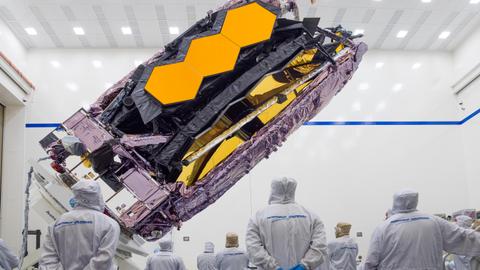The James Webb Space Telescope has discovered the four most distant galaxies ever observed, one of which formed just 320 million years after the Big Bang, new research said.
In two studies published on Tuesday in the Nature Astronomy journal, astronomers revealed they have “unambiguously detected” the four galaxies.
The galaxies are from what is called “the epoch of reionisation,” a period when the first stars are believed to have emerged. The epoch came directly after the cosmic dark ages brought about by the Big Bang.
The Webb telescope has unleashed a torrent of scientific discovery since becoming operational last year, peering farther than ever before into the universe’s distant reaches – which also means it is looking back in time.
By the time light from the most distant galaxies reaches Earth, it has been stretched by the expansion of the universe and shifted to the infrared region of the light spectrum.
The Webb telescope’s NIRCam instrument has an unprecedented ability to detect this infrared light, allowing it to quickly spot a range of never-before-seen galaxies – some of which could reshape astronomers’ understanding of the early universe.
READ MORE:
NASA: First African-American astronaut to join lunar mission Artemis II
Here’s a time lapse video of the LEGO version of the James Webb Space Telescope.
[Visit: https://t.co/W6obHY1PKK]pic.twitter.com/WXdWmkpB5u
‘Technical tour de force’
Stephane Charlot, a researcher at the Astrophysics Institute of Paris and co-author of the two new studies, said all four galaxies are “very low in mass,” weighing roughly a hundred million solar masses, Charlot said.
The Milky Way, in comparison, weighs 1.5 trillion solar masses by some estimations.
But the galaxies are “very active in star formation in proportion to their mass,” Charlot said.
Those stars were forming “at around the same rate as the Milky Way,” a speed that was “surprising so early in the Universe,” he said.
The galaxies were also “very poor in metals,” he added.
This is consistent with the standard model of cosmology, science’s best understanding of how the universe works, which says that the closer to the Big Bang, the less time there is for such metals to form.
However, in February, the discovery of six massive galaxies from 500-700 million years after the Big Bang led some astronomers to question the standard model.
Those galaxies, also observed by the Webb telescope, were bigger than thought possible so soon after the birth of the universe – if confirmed, the standard model could need updating.
Pieter van Dokkum, an astronomer at Yale University not involved in the latest research, hailed the confirmation of the four newly-discovered distant galaxies as a “technical tour de force”.
“The frontier is moving almost every month,” van Dokkum commented in Nature, adding that there was now “only 300 million years of unexplored history of the universe between these galaxies and the Big Bang”.
The Webb telescope has observed possible galaxies even closer to the Big Bang, but they have yet to be confirmed, he said.
READ MORE: What’s a 3D-printed rocket and why it’s the next big thing in space travel



